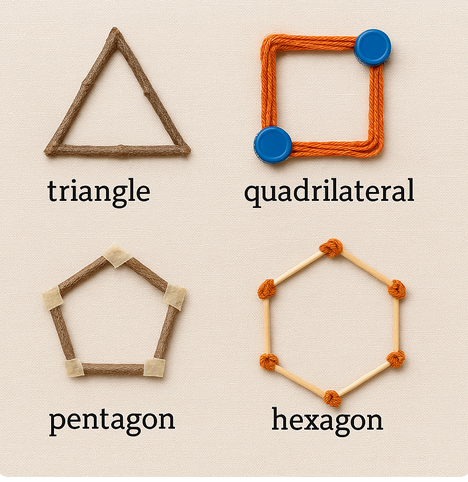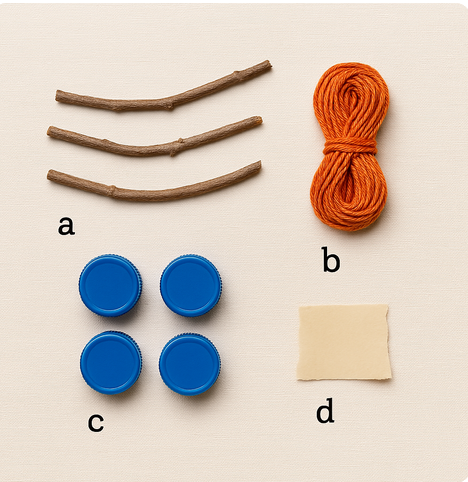Solution 1.
(a) Find the area using Heron’s formula.
\begin{align*}
A \amp = \sqrt{(s(s - a)(s - b)(s - c))}
\end{align*}
\begin{align*}
s \amp = \frac{(a + b + c)}{2}
\end{align*}
\begin{align*}
s \amp = \frac{(10+7+9)}{2}\, cm
\end{align*}
\begin{align*}
\amp = 13 \, \text{cm}
\end{align*}
Substitute in the values.
\begin{align*}
A \amp = \sqrt{(13(13 -10)(13 - 7)(13 - 9))}
\end{align*}
\begin{align*}
A \amp = \sqrt{(13 \text (6)\times(3)\times(4))}
\end{align*}
\begin{align*}
A \amp = \sqrt{936}
\end{align*}
\begin{align*}
\amp = 30.6 \, \text{cm}^2
\end{align*}
The area of the triangle is \(\, 30.6 \text{cm}^2\text{.}\)
(b) Find the angles using the sine area formula.
\begin{equation*}
A = \frac{1}{2} \,\text{ab sin C}
\end{equation*}
\begin{equation*}
A = 30.6 \, \text{ cm}^2
\end{equation*}
To find \(\angle HFG\) Using sides \(a = 10\) and \(b =7 \) and area\(= 30.6 \,\text{cm}^2\)
\begin{align*}
30.6 \, \text{cm}^2 = \amp \frac {1}{\cancel{2}} \times \cancel{10} \, 5\, \text{cm} \times 7\, \text{cm} \times \text{sin} \, A\\
\text{Sin A} = \amp \frac{30.6 \cancel{\text{cm}}^2 \,\text{cm}}{35 \cancel{\text{cm}} }\\
\text{sin A} = \amp 0.8743\\
A = \amp sin^{-1} \, {0.8743} \\
= \amp 60.96^\circ
\end{align*}
To find \(\angle FGH\) Using sides \(a = 10\) and \(b =9 \)and area\(= 30.6 \,\text{cm}^2\)
\begin{align*}
30.6 \, \text{cm}^2 = \amp \frac {1}{\cancel{2}} \times \cancel{10} \, 5\, \text{cm} \times 9\, \text{cm} \times \text{sin} \, C \\
\text{Sin C} = \amp \frac{30.6 \cancel{\text{cm}}^2 \,\text{cm}}{45 \cancel{\text{cm}} }\\
\text{sin C} = \amp 0.68\\
C = \amp \text{sin}^{-1} {0.68} \\
= \amp 42.84 ^\circ
\end{align*}
To find the \(\angle GHF \) we use the angle sum property.
\begin{align*}
\angle GHF = \amp 180^\circ - (\angle FGH + \angle HFG)\\
= \amp (180 - 103.80)^\circ\\
= \amp 76.2^\circ
\end{align*}
Similarly we can use the Sin A rule which states that :
\begin{equation*}
\frac{ \text{sin A}}{a} = \frac{ \text{sin B}}{b} = \frac{ \text{sin C}}{c}
\end{equation*}
\begin{align*}
\frac{ \text{sin B}}{b} \amp = \frac{ \text{sin C}}{c} \\
\frac{ \text{sin B}}{10 \,\text{cm}} = \amp \frac{ \text{sin 0.8743}}{9} \\
\text{sin} \, B = \amp 0.9714\\
= \amp \text{sin}^{-1} \, 0.9714\\
B = \amp 76.2^\circ
\end{align*}
Solution 2.
(a) Find the length of the perpendicular from A to BC.
The formula for area using base and height.
\begin{align*}
A = \amp\frac{1}{2} \times base \times height \\
28.1 \text{cm}^2 = \amp \frac{1}{2}\times b \times h \\
h = \amp \frac {2 \times 28.1}{BC}
\end{align*}
(b) Finding BC using sine rule
\begin{align*}
A = \amp \frac{1}{2} \times AB \times BC \times \text{sin} \, \theta \\
28.1 \,\text{cm}^2=\amp \frac{1}{2} \times 7.2\,\text{cm} \times BC \times \text{sin} \, \, 48.6^\circ \\
\text{sin} \, 48.6^\circ = \amp \, 0.7501\\
28.1 \,\text{cm}^2=\amp \frac{1}{2} \times 7.2\, \text{cm}\times BC \times \text{sin} \, 0.7501 \\
BC = \amp \frac{28.1 \times 2}{7.2 \times 0.7501} \\
= \amp 10.4 \, \text{cm}
\end{align*}
Now substituting BC into the height equation :
\begin{align*}
h = \amp \frac{2 \times 28.1}{10.4}\\
=\amp 5.4 \,\text{cm}
\end{align*}




